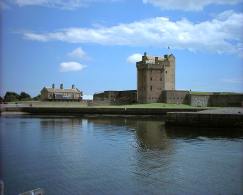 |
The
external features of the castle The internal features of the castle The castle's relationships with its surroundings |
Broughty Castle
 |
The
external features of the castle The internal features of the castle The castle's relationships with its surroundings |
A brief history
Broughty Castle has a long and interesting history, involving many changes to its structure and its surroundings. The site was first mentioned in 1454 when George, the fourth Earl of Angus, received permission from James II to build a small fort there, but it was the second Lord Gray who built the tower house that still forms the core of the castle, in 1496.
In the 1540s, the castle played a part in the conflict between Scotland and England, being attacked and captured by both sides. Later in the 16th century the castle's fortifications were strengthened because of the importance of the site. In 1651 the castle was attacked again by General Monck, and its defenders fled. By 1787, the castle had fallen into disrepair, and it remained in ruins for some time.
In 1846, the castle was acquired by the Edinburgh and Northern Railway Company, and a railway ferry was built next to it, along with a harbour. A few years after that, the War Office bought the castle, in order to defend the entrance to the River Tay against the threat of Russian ships near the end of the Crimean War. In 1860, further changes were made to the castle when it was feared there would be a war with France. The walls of the main courtyard were rebuilt, and a new wing was added to the tower. Emplacements for guns were added, so that the castle became a defended coastal battery.
In 1886-87 the castle was altered again, to accommodate the Tay Division Submarine Miners, whose job it was to lay a minefield across the River Tay in an emergency. The submarine miners were given two steam-powered minelaying ships, which were among the first ships of this kind ever built. The gun emplacements were altered in 1889-91 and equipped with newer guns, and the Castle Green battery was built near the castle. Further alterations were made to the castle during both World Wars. A defence post was constructed at the top of the tower in 1942, during World War II. The castle is now in the care of Historic Scotland, and the tower has housed a museum since 1969.
